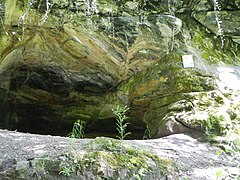Gudenus cave
Cave and archaeological site in Austria From Wikipedia, the free encyclopedia
The Gudenus cave (German: Gudenushöhle) is an archaeological site near the city of Krems in north-eastern Austria. It is noted for its fossils and remains of Palaeolithic human settlers.
Gudenushöhle | |
 Gudenus cave interior | |
| Location | near Lichtenau im Waldviertel |
|---|---|
| Region | Lower Austria |
| Coordinates | 48.44682°N 15.3956°E |
| History | |
| Periods | Paleolithic |
Description
The Gudenus cavern is situated 20 km (12 mi) northwest of the city of Krems, in the valley of the Little Krems, not far from Willendorf, in Lower Austria.[1] The site is close to the River Danube.[2] The cave is 22 m (72 ft) long with a width of 2 to 3 m (6.6 to 9.8 ft) and is situated 7.5 m (25 ft) above the level of the stream.[1]
- left entrance area
- right entrance area
Paleontology
The archaeological deposit has yielded bones of numerous animals, including Woolly mammoth, Woolly rhinoceros, Aurochs, Chamois, Reindeer, and Red deer.[1] Human artifacts include numerous flint implements beginning with the Mousterian (i.e. Neanderthals) of the Middle Paleolithic, although there is no certainty as to the dating.[2] There is also an Upper Palaeolithic, Magdalenian, assemblage including an engraved reindeer bone,[3] and a fragment of a bone flute dated to about 16,000–10,000 BCE.[4]
References
External links
Wikiwand - on
Seamless Wikipedia browsing. On steroids.



